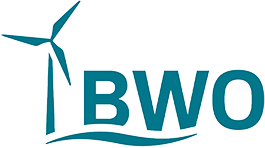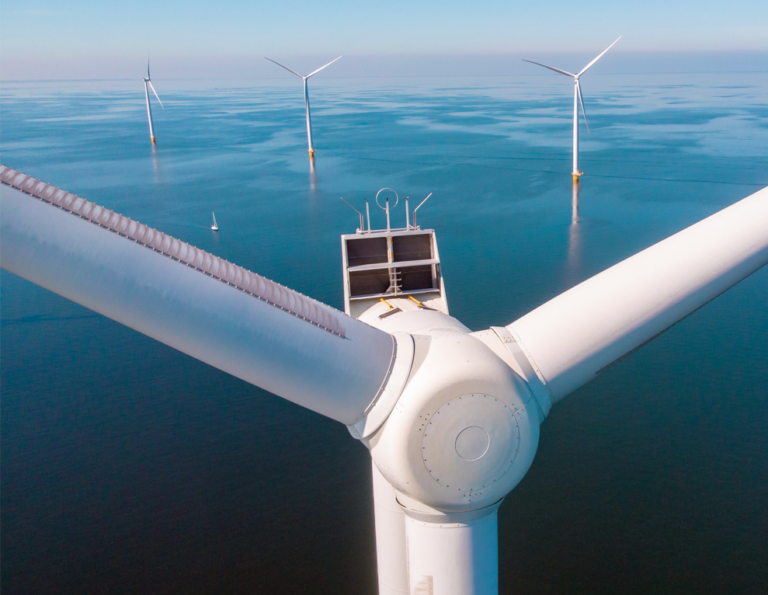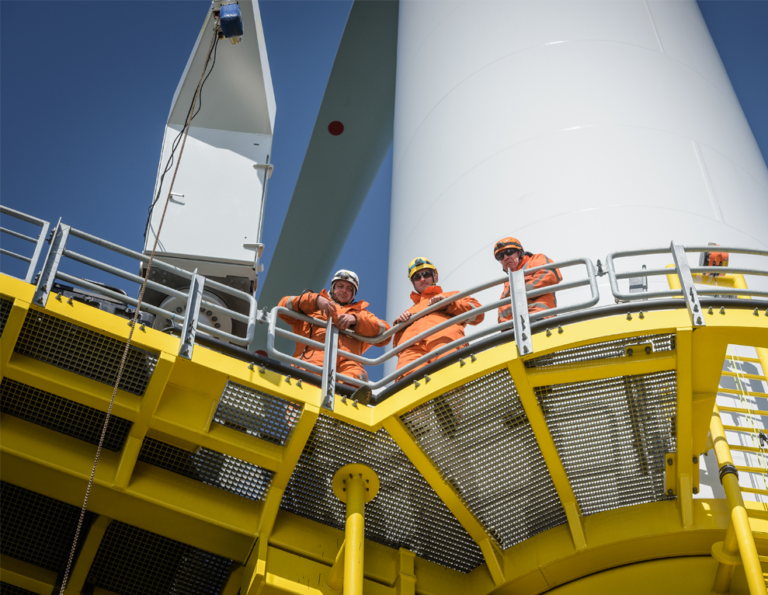With wind energy at sea for climate neutrality
Recommendations for action
As the Federal Association of Offshore Wind Farm Operators, the energy transition and complete decarbonisation by 2050 are very important to us. From our point of view, the following projects are important for the next legislative period:
While the debate about land and acceptance on land is already in full swing, there are also increasing conflicts of interest at sea between conservationists, fishermen, shipping, raw material extraction, the military and offshore wind power. It is correct that the expansion of wind turbines at sea must take into account existing forms of use and must also be environmentally friendly. However, it is also correct that we can only prevent a shift or shortage of habitats for many species in the long term if the goals of the Paris Climate Agreement are met.
At the same time, the expansion of offshore wind energy is even more dependent on the expansion of the grid than is the case with other renewable energies. Much progress has been made here in the current legislature. At the same time, the amendment to the offshore wind energy law linked the further expansion of offshore wind power to progress made in expanding the grid. In order for these measures not to prevent the achievement of the targets, the network expansion has to pick up speed even further.
Recommendations:
- Ensure constant expansion path: The amendment to the offshore wind energy law has raised the expansion targets for 2030 to 20 GW and introduced a new target for 2040 of 40 GW. This step was only logical in view of the cost reductions and the increasing demand for green electricity. At the same time, the current halt to construction (no new offshore wind farms will go into operation in 2020 and 2021) is causing problems for the industry. In the future, it will be necessary to secure and stabilize the achievement of the goals in the long term and to show the necessary areas in the spatial planning and the area development plan. To this end, we are proposing a binding interim target of 30 GW offshore wind by 2035 and an early update of the area development plan (FEP) to determine areas for achieving the 40 GW target.
- Defuse land conflicts: In order to defuse usage conflicts, the EU Commission developed the co-usage approach. The scarce ocean space should therefore - if possible - be used by several actors at the same time. This idea should be further developed and used in Germany as well. To this end, we recommend pilot projects and a national discussion process on shared marine space use.
- Advancing network expansion and use: Not least because of the new requirements for grid synchronization, delays in the expansion of the grid lead to delays in the expansion of offshore wind power. The costs of curtailment also lead to unnecessary costs and inefficient use of the valuable energy source. To this end, we recommend accelerating the expansion of the network and improving the use of the existing network through digitization and upgrading.
The current market design is designed for the financing of conventional generation plants with fuel costs and leads to inefficiencies and unnecessary burdens for consumers and the economy when financing renewable energy plants. The 2021 EEG amendment also mandates the federal government to examine by 2027 at the latest how the expansion of renewable energies can take place without state funding. For this to be possible, a discussion about the rules of the energy markets is necessary.
In order to secure the process in terms of acceptance and general good, we suggest five criteria for the target design:
- Future viability: The decarbonisation of the electricity sector will be achieved well before 2050.
- Observance of the energy policy triangle: The criteria for climate protection goals, security of supply and cost efficiency must be achieved.
- Cost efficiency through competition: The new market design strengthens competition. The players in the energy market take on and manage opportunities and risks as far as this is possible and economically efficient. In return, unforeseeable and therefore unproductive opportunities and risks must be avoided.
- Suggestion for investments: The new store design creates the basis for stable and reliable investments and thus strengthens the trust of national and international investors.
- Conformity with the EU internal energy market: Last but not least, the new market design must be compatible with Europe, not only from a legal point of view (that goes without saying), but also with regard to future cross-border projects and the development of the internal energy market.
Other Recommendations:
- Contracts for difference for offshore wind: In the case of contracts for differences, the bidder uses a competitive procedure (tender) to set a price with his bid at which he would sell the electricity from the offshore wind farm if a bid was accepted. If the market price of the electricity is below the awarded price, the system operator receives the difference, analogous to the current market premium. However, if the market price is higher than the awarded price, the profits must be repaid. The BWO continues to advocate the introduction of contracts for difference as a financing instrument for offshore wind farms. The advantage of this system is that it reduces the unproductive risks (e.g. subsequent changes to the legal framework on the electricity market). Risk surcharges, which had to be included as a buffer in the past, are no longer necessary and consumers are relieved. In this way, electricity generation costs can be reduced by around 30 percent. This strengthens the international competitiveness of the German economy, secures jobs and added value.
- Remove barriers to green PPAs: For plants that have reached the end of the EEG subsidy, fall outside the basic remuneration or even manage without subsidies from the start, green electricity purchase contracts offer an economic perspective.
The amendment to the WindSeeG has made some suggestions as to how the offshore expansion can be accelerated. According to the BWO, there is still one here Need for discussion on the question of how the acceleration of the expansion can be reconciled with the associated challenges for the project developers. A consistent implementation concept for further accelerated offshore expansion can only be worked out in the context of a specialist dialogue. This specialist dialogue should be initiated promptly by the BMWi and BSH. The implementation deadlines specified in Section 59 WindSeeG are a central control instrument, but must also be seen in conjunction with the provisions in Section 17d EnWG on the network development plans and the area development plan as well as the specifications in the area development plan.
Germany and the EU are aiming for CO2 neurality in their economies by 2050. Since direct electrification cannot be technically or economically feasible in all applications, synthetic energy sources based on renewable energies (Power-to-X) are an indispensable element for complete decarbonization. Hydrogen can be used in a variety of ways and is the starting material for other synthetic energy carriers and raw materials. When building a hydrogen economy in Germany, the focus should be on green hydrogen from the start, which is obtained from renewable energies.
The BWO expressly welcomes the initiative of a National Hydrogen Strategy (NWS) and the associated approach of developing a comprehensive energy management and industrial policy strategy that takes into account the entire value chain (technologies, components, generation, storage, infrastructure and logistics). Further changes are necessary so that offshore wind can make a contribution to the production of green hydrogen.
Recommendations:
- Anchoring specific goals: Currently, the NWS only stipulates that generation plants with a total output of up to 2030 GW including the necessary offshore and onshore energy generation should be built by 5. A specific and binding target for the generation of green hydrogen from offshore wind would be very helpful for future development.
- Designation of other other energy generation areas: So-called other energy generation areas have been introduced for the production of hydrogen at sea and so far have a size of 35,1 km2. This size is not sufficient for a significant production of hydrogen at sea. This designation of further and, if possible, large, contiguous other energy generation areas is therefore imperative.
- Define the tendering and awarding regime for the hydrogen areas: So far, no award mechanisms have been defined for the other energy generation areas. In order to ensure that possible projects are implemented in a timely manner, the award mechanism should be defined as quickly as possible.
- Ensure level playing field for green hydrogen: Green hydrogen is currently comparatively expensive. In order to enable equal opportunities with simultaneous decarbonisation, it is necessary to bring green hydrogen to the same cost level as fossil hydrogen. An effective Co2 price would help. The CO2030 pricing introduced in the climate protection program 2 in the transport and heating sectors with a simultaneous reduction or reallocation of the EEG surcharge is a step in the right direction to reduce the imbalance. For a transition phase, market-based instruments such as competitive tendering for green hydrogen are a viable option. The introduction of a CfD mechanism for hydrogen could also help.
- Solve transport efficiently: The innovative hydrogen production at sea in close proximity to electricity generation is very promising. Holistic solutions for the transport of this hydrogen, ideally via a pipeline, are in line with the energy transition and should be made possible by regulatory means.
The EU offshore strategy provides for an expansion target of 2050 GW offshore wind for the European Union by 300. In order to secure the expansion targets in the long term and to enable European planning, Germany should also set an expansion target for 2050.
In addition, international cooperation should be further developed, as was recently called for by the North Sea Energy Cooperation under the German chairmanship. This includes, on the one hand, offshore wind projects that are connected in at least two countries. This has the advantage that in addition to the removal of the electricity generated in the wind farm, the mutual exchange of electricity would also be possible. On the other hand, joint projects should also be taken into account that enable states with little development potential or without coastal waters to participate in a Europe-wide expansion of offshore wind energy and the associated goals through financial contributions.
With the further expansion of offshore wind energy, the complexities and challenges for the operation of offshore wind farms also increase significantly. The German wind farms are already located up to 120 km from the coast and are also being built significantly further out in the North Sea. The distance and the increase in wind farms place new and increased demands on safety and infrastructure in the German seas.
While federal and state authorities are increasingly regulating the offshore sector, a discussion on the meaningful delimitation between state and private services of general interest has not yet taken place sufficiently. This can be explained, among other things, with an unclear federal-state responsibility in the German foreign trade zone (EEZ).
The offshore wind industry already provides infrastructure (e.g. rescue helicopters) that also benefit the common good without, conversely, being included in a maritime state provision of general interest, as it is shared with other interests of use (e.g. shipping).
Against this background, we encourage a dialogue between the federal government, the federal states and the industry. The aim is to find a sensible distribution of responsibility and burdens between the state and business and at the same time to improve safety at sea.



